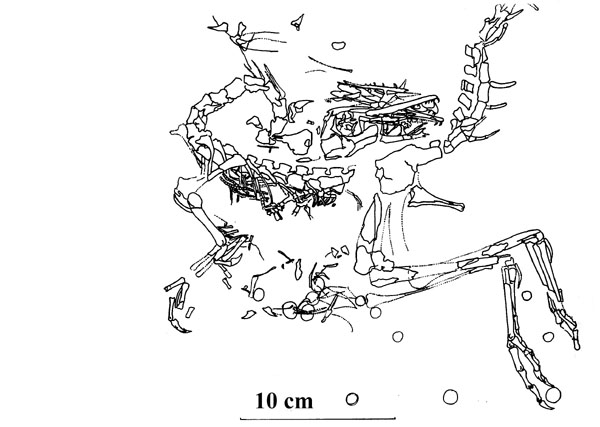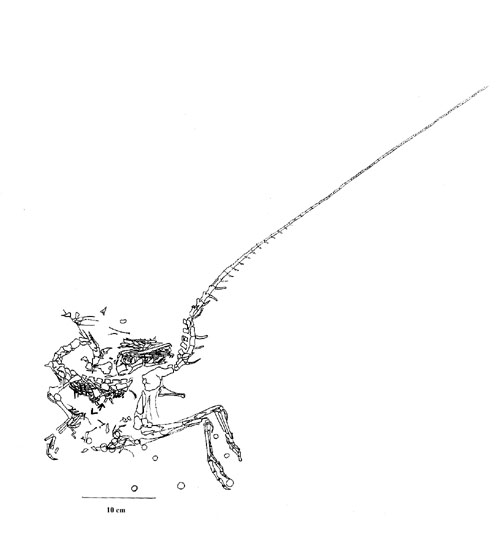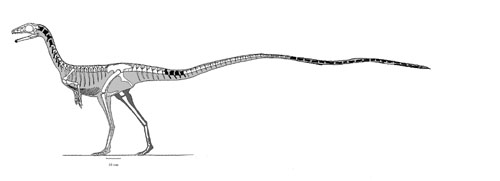
Species: longipes WAGNER, 1859
Etymology: Latin, longus, "long" and Latin, pes, "foot"; Long foot.
Holotype: IPHG ASI 563 (BSP 1563)
Locality: Exact locality unknown, Jachenhausen? Bayern (Bavaria) State, Germany.
Horizon: Lithographic, Solnhofen.
Biostratigraphy:
Age: Tithonian Stage, Upper Malm Epoch, Late Jurassic.
Material: Skull and skeleton.


Skull after Ostrom, 1978

Note: Partial skeleton of the lizard Bavarisaurus cf. macrodactylus found in stomach area.
Note: Remains of 10 or more small eggs found in body cavity of type.
Note: Ostrom (1978) "A striated or linear pattern does occur proximally
at the lower edge of the ischium, and also between the right radius and ulna.
In both of these sites, the striations are parallel to the adjacent
bone edges. There also appears to be a very faint lineation along the dorsal
region of the proximal caudals close to the tip of the right dentary. Nopsca's "fibers" may
well represent impressions of soft tissues." Or possible feather impressions?
Note: Furcula has been found (SVP talk PEYER, 2003).
Referred material:
AZUMA, 2005
FPDM-V6229: Free mounted cast of skeleton.
LYDEKKER, 1888
BMNH 49159: Cast of type.
McINTOSH, 1981
CM 53: Cast of type
= Compsognathus corallestris BIDAR, DEMAY & THOMEL, 1972
Etymology: The specific name of the Varois species was chosen to reflect its presumed mode of life, on coralline atolls.Holotype: MNHN CNJ 79
Locality: <<Petit Plan>>, Canjuers, Var Department, France.
Horizon: Portlandian Lithographic limestone.
Biostratigraphy:
Age: Lower Tithonian Stage, Malm Epoch, Late Jurassic.
Material: Skull and nearly complete skeleton.
Note: Furcula has been found (PEYER, 2006).Note: Pathology on the left metatarsal IV. The proximal third of the shaft is swollen to almost three times its normal diameter measured below and above this anomaly. The shaft has no visable brakage at teh level of the pathology, indicating that a possible fracture healed before death. Possible a stress fracture (PEYER, 2006).
Note: Possible skin impressions distal to caudal 12 displays patches of uniformly siezed, bumpy structures on the lateral sides (PEYER, 2006).
Note: Has impressions of the gastrointestinal remnants. Also disparate sizes of cervical, dorsal vertebrae as well as scattered placement of a coracoid and pelvic elements among the gastric contents suggets multiple individuals within the gastric area (possibly belonging to sphenodontids or lizards) (PEYER, 2006).
After Peyer, 2006
Referred material:
FMNH PR 425: Cast of type.